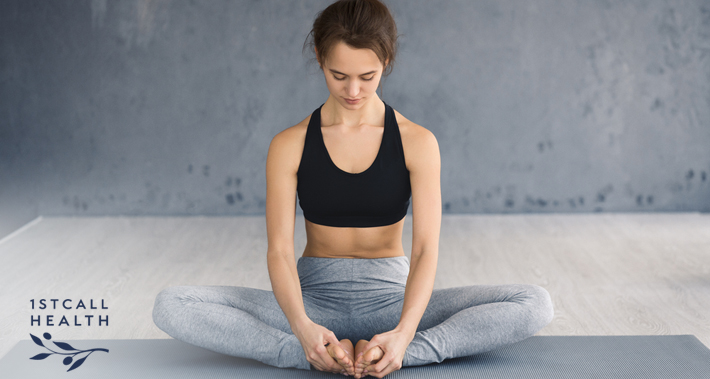
Back pain is something most people will experience in their lifetimes.
Your back is the core of most of your movement, which means it’s also more likely to be injured or strained than other parts of your body.
But when it comes to pain management, there’s a lot you can do.
Here at 1stCallHealth, we’re a Washington DC primary care clinic, and we often see patients with chronic pain issues.
There are pharmaceutical solutions, of course.
But it you’re like many people today, you might prefer a more natural pain solution, like yoga.
But how can yoga help your back?
Let’s find out.
What Is Back Pain?
Back pain is a common health concern.
In fact, it’s the most commonly discussed issue at primary care visits.
You can experience anything from constant, dull pains to sudden shooting pains.
It may be caused because you experienced an accident or injury, or it may come on slowly due to age.
One study estimates that 84% of the population will experience back pain at some point in their life.
Are There Different Types Of Back Pain?
There are many different kinds of back pain because there are so many areas of your back that can be affected.
However, generally doctors describe back pain in three different ways.
Chronic back pain can start suddenly or over time, occurs daily, and lasts longer than twelve weeks.
Acute back pain starts suddenly and usually lasts only a few days or weeks.
Finally, subacute back pain comes on suddenly or over time and usually lasts from four to twelve weeks.
What Causes Back Pain?
There are a lot of different causes for back pain.
If you experience chronic back pain, it’s often due to multiple causes that interact with each other.
Sometimes, no one cause can be identified as the cause of your back pain.
However, there are some common causes of back pain, such as:
- A sprain to the ligaments that support your back
- Straining the muscles or tendons in your back
- Degenerative disc disease
- Herniated or ruptured discs
- Spinal stenosis
- Fractured vertebrae
- Scoliosis
- Myofascial pain
- Poor posture
- Poor workplace ergonomics
- Arthritis
- Osteoporosis
- And more
Some people may also have inflammatory conditions or other medical conditions that can cause or increase sensitivity to back pain.
How Does Back Pain Feel?
Your back pain might feel different depending on the area of your back that is experiencing pain and the type of pain you are experiencing.
You might experience pain in one specific spot, but you could also experience pain that radiates out to different areas of your body, like your abdomen or legs.
Depending on all these factors, you might experience:
- Pain in your back that gets worse when you sit, rest, or stand
- Pain in your back that comes and goes
- Pain that radiates from your back into your legs, hips, or butt
- Pain that gets worse when you lift or bend
- Pain in your back that comes and goes
- A stiff back when you wake up in the morning
- Pain that decreases with physical activity
Medical Treatments For Back Pain
Just like there’s a wide range of causes and types of back pain, there’s also a wide range of treatment options.
Often, back pain will resolve within about a month of treating it at home with rest and anti inflammatory medications like ibuprofen.
If home treatment doesn’t help your back, there are other things you can try.
Medications
There are some medications that can be helpful depending on the type of pain you are experiencing.
Anti inflammatory drugs like ibuprofen are commonly recommended.
But if usual over the counter options aren’t working, you might be provided a prescription for a stronger anti inflammatory.
Pain relief creams or patches might also be a useful home treatment to use along with anti inflammatory drugs.
When pain relievers don’t work, muscle relaxants can also be used, however they can make you tired and dizzy.
Physical Therapy
Physical therapy may be recommended by your healthcare provider to help improve your symptoms of back pain.
Physical therapy works by strengthening your muscles to improve your posture, which can help prevent pain and keep it from returning.

Why Do We Avoid Opioids For Back Pain Treatment?
Opioids include prescription pain medications like morphine, codeine, and oxycodone.
They can be used to treat pain, but usually aren’t a good option.
Even with minimal and highly supervised use, opioid addiction can develop very quickly.
Opioid addiction can occur both physically and mentally, which means your body craves the drug and you consciously desire the drug’s effects.
Long term opioid usage also has serious health effects and can keep your brain from producing its own natural pain killers.
Even short term use can actually increase your brain’s baseline sensation of pain.
Opioid withdrawal symptoms are often severe as well.
In general, opioids are generally recommended only in cases of severe pain, and only on a temporary basis.
They’re also sometimes used in palliative care.
Otherwise, opioid addiction is a serious problem in the United States, so it’s best to avoid treatment of pain with opioids unless absolutely necessary.
How Can Yoga Help With Back Pain?
Yoga, along with Tai Chi, Pilates, and other activities, as been proven to help reduce most back pain.
Yoga in particular is great because it focuses on maintaining back strength and flexibility.
This can improve your posture and your ability to move in a way that won’t cause injury or trigger back pain.
It can be especially helpful for the muscles that support your back and spine.
On top of all the physical benefits, yoga also encourages a connection with your body which has been shown to lower stress and alleviate anxiety.
Both stress and anxiety can often be caused by the experience of back pain.
Yoga Stretches For Back Pain
Below, you’ll find some recommended stretches and best practices for using yoga to relieve back pain.
Seated Cross Legged
Sit cross legged on the floor, with your posture straight.
Head above shoulders, shoulders above chest, chest above belly, belly above bum.
Gently lean forward, then alternate which leg is on top, and lean forward again.
Keep your spine straight as you go.
Spinal Twists
In the same seated position, gently turn your body to the left.
Reach behind with your left arm, and turn your head back as well.
Keep your spine straight as you do.
After a moment, return your spine to the middle, then do the same with the right side.
Butterfly Position
Take a similar seated position, but instead of sitting cross legged, touch the bottom of your feet together.
Allow your knees to fall to the side.
If it feels right, you can gently move your knees up and down as well, but keep your feet in the same position.
Happy Baby Position
Lay down on your back.
Then, pull your knees up to your chest or to either side of it.
In this pose, rock gently from side to side on your hips.
Standing Back Bend
Stand up straight, with your feet shoulder width apart.
Place your arms on the small of your back, or above your head with your fingers interlocked.
Then, gently lean forward.
Allow your knees to bend as the top half of your body folds over.
If it feels right, take some deep breaths, and each time you exhale see if you can find a deeper stretch.
How To Do Yoga For Back Pain Safely
Despite how helpful yoga can be for back pain, injuries can still happen, just like with any other form of physical activity.
There are a few ways you can protect your back while you do yoga to make sure you are only improving your back pain, not adding to it.
If you’re going to yoga classes, the best thing to do is always to let your yoga instructor know about your back pain.
Once they know, they can guide you through modifications to certain poses or help you make sure you’re doing poses correctly so you don’t hurt your back.
In general, though, some best practices for yoga include:
Dynamic Stretching
Keep your stretches gentle, and relax into your pose.
This helps your muscles to relax, and allows for a deeper, more effective stretch.
Oppositional Muscle Stretching
One of the focuses of yoga is balance, and not just in terms of being able to hold complicated poses without falling over.
If you’re extending your muscles in one area, make sure you’re stretching their oppositional muscles as well.
For example, if you lean back and extend your spine, make sure you also lean forward.
And if you stretch the front of your leg, also stretch the muscles on the back of your leg, too.
Be Gentle
Yoga is meant to be gentle.
This is especially true if you’re already in pain.
Keep your stretches small and relaxing, and don’t overexert yourself.
If something doesn’t feel right – or hurts – book an appointment with us at 1stCallHealth.
Book Your Appointment With 1stCallHealth Today
If you’re dealing with any kind of back pain, we’re here to help.
Book your appointment with 1stCallHealth today.
1stCallHEALTH
1331 H St NW Ste 200,
Washington, DC 20005
(202) 590-0009
– https://goo.gl/maps/MVhjkz2jqynWpsgo6
1stCallHEALTH provides affordable access to primary care services. We believe that everyone deserves affordable, high quality primary care.
Our vision is to challenge the status quo, focus on the individual, and empower personal control to change the way we think about healthcare.




